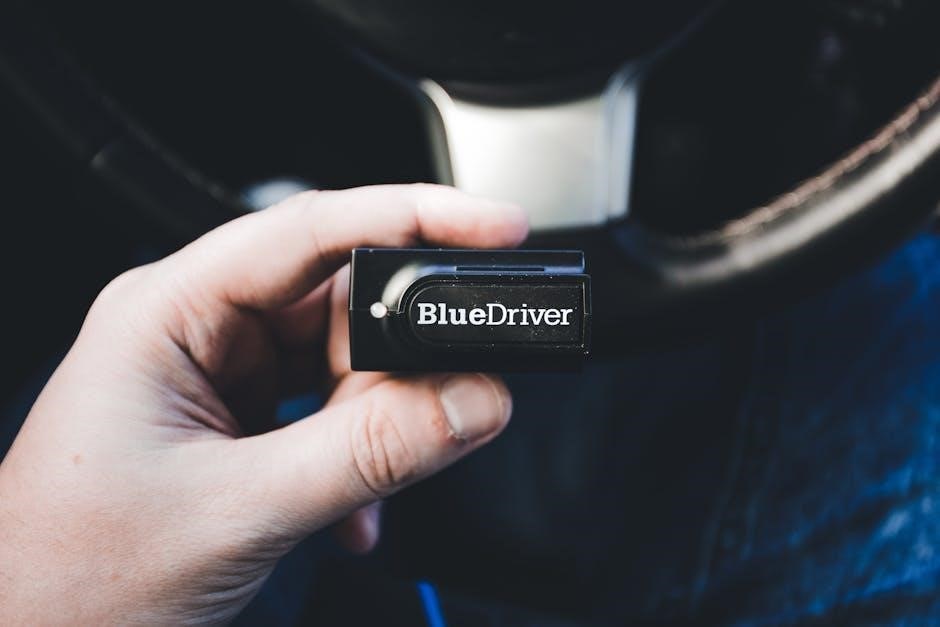obd2 scanner manual

An OBD2 scanner is an essential tool for modern vehicle diagnostics, enabling users to monitor performance, identify issues, and access real-time data. It empowers both professionals and DIY enthusiasts to maintain and repair vehicles efficiently, ensuring optimal functionality and safety. This manual provides a comprehensive guide to understanding and utilizing OBD2 scanners effectively.
What is an OBD2 Scanner?
An OBD2 scanner is a diagnostic tool that connects to a vehicle’s onboard computer (ECU) via the OBD-II port, typically located under the dashboard. It retrieves error codes, providing insights into vehicle performance, emissions, and potential issues. By communicating with the vehicle’s systems, it helps identify problems such as engine faults or emissions-related concerns. The scanner displays real-time data from sensors, enabling users to monitor parameters like engine speed, temperature, and oxygen levels. It also allows clearing of fault codes after repairs. This versatile device is essential for both professional mechanics and DIY enthusiasts, offering a user-friendly interface for troubleshooting and maintaining vehicle health.
Importance of an OBD2 Scanner for Car Maintenance
An OBD2 scanner is a vital tool for proactive car maintenance, offering insights into a vehicle’s health by detecting issues early. It helps identify fault codes, monitor emissions, and track real-time performance metrics, enabling timely repairs and preventing costly damage. By providing detailed diagnostics, it empowers users to address problems before they escalate, ensuring safety and efficiency. Regular use of an OBD2 scanner promotes better fuel efficiency, reduces emissions, and extends the lifespan of the vehicle. It is an indispensable resource for both professional mechanics and DIY enthusiasts, fostering a deeper understanding of their vehicle’s condition and enhancing overall maintenance routines;
Brief History of OBD2 Technology
OBD2 technology emerged in the 1990s as a standardized system for vehicle diagnostics, building on earlier OBD1 systems. Initially introduced to monitor emissions, it evolved to provide comprehensive insights into engine performance and fault detection. By the mid-1990s, OBD2 became mandatory in the U.S., ensuring uniformity across vehicles. This advancement enabled real-time data access, detailed fault codes, and system monitoring, revolutionizing car maintenance and diagnostics. Its widespread adoption has made it indispensable for both professionals and enthusiasts, continually advancing with technological improvements to enhance accuracy and functionality in modern vehicles.

Technical Specifications of OBD2 Scanners
OBD2 scanners feature compatibility with OBD2 standards, high-speed processors, and robust memory for storing data. They support various protocols and offer advanced diagnostic capabilities for accurate vehicle monitoring.
Compatible Vehicles and OBD2 Standards
OBD2 scanners are compatible with vehicles manufactured from 1996 onward, adhering to the OBD2 standard. This standard ensures uniformity in diagnostic protocols across vehicles. Key protocols include ISO 15765-4 (CAN), SAE J1850 PWM, and SAE J1850 VPW. These scanners work with passenger cars, trucks, motorcycles, and even marine applications. Compatibility varies by vehicle make and model, but most modern vehicles support OBD2. Some scanners also support heavy-duty vehicles (J1939) or specialized systems. Always verify your vehicle’s OBD2 compliance and supported protocols before purchasing a scanner to ensure proper functionality and compatibility.
Types of OBD2 Scanners: Basic vs. Advanced
OBD2 scanners are categorized into basic and advanced models, catering to different user needs. Basic scanners provide essential functions like reading and clearing fault codes, checking engine light status, and viewing basic vehicle information. They are ideal for DIY enthusiasts and casual users. Advanced scanners, however, offer enhanced features such as live data monitoring, customizable settings, and detailed diagnostic reports. They often support multiple protocols and are designed for professionals or serious car enthusiasts. Some advanced scanners also include Bluetooth or Wi-Fi connectivity for smartphone app integration, enabling real-time data streaming and advanced analytics. Choosing the right type depends on your diagnostic requirements and technical expertise.
Key Features to Look for in an OBD2 Scanner
When selecting an OBD2 scanner, consider compatibility with your vehicle’s make and model, as well as support for multiple OBD2 protocols. Real-time data monitoring and live sensor readings are crucial for diagnosing issues. Look for a scanner that can read and clear fault codes, including pending codes, and display detailed code definitions. Wi-Fi or Bluetooth connectivity enables smartphone app integration for enhanced functionality. A user-friendly interface, such as a color screen or mobile app, improves ease of use. Additional features like freeze frame data, vehicle information display, and data logging can be beneficial for advanced diagnostics. Ensure the scanner is updated regularly for optimal performance and compatibility.

Installation and Setup
Installing an OBD2 scanner involves connecting it to your vehicle’s OBD port, typically under the dashboard. Turn the ignition on and pair the scanner with your car’s system for proper communication and diagnostics.
Step-by-Step Installation Guide

- Locate the OBD2 port, usually under the dashboard on the driver’s side.
- Plug the OBD2 scanner into the port until it clicks securely.
- Turn the vehicle’s ignition to the “ON” position but do not start the engine.
- Wait for the scanner to power on and initialize.
- Follow on-screen prompts to select your vehicle’s make and model.
- Allow the scanner to establish communication with your vehicle’s ECU.
- Once connected, you can begin scanning for codes or monitoring live data.
This process is straightforward and ensures proper setup for accurate diagnostics.
Software and Firmware Setup
Install the provided software or download the latest version from the manufacturer’s website. Launch the application and follow the on-screen instructions to complete the installation. Update the firmware by connecting the scanner to your computer via USB or wirelessly, depending on the model. Ensure your device is fully charged or connected to a power source during updates. After installation, register the scanner using the provided serial number to access premium features and support. Regularly check for software updates to maintain compatibility with new vehicle models and diagnostic protocols. Proper setup ensures optimal performance and accurate diagnostics.
Pairing the Scanner with Your Vehicle
Locate the OBD2 port, typically under the dashboard near the steering wheel. Plug in the scanner firmly to ensure a secure connection. Turn the ignition to the “ON” position without starting the engine. The scanner will automatically power up and initiate a connection. If pairing a wireless or Bluetooth scanner, open the paired app or software and select the scanner from the available devices list. Ensure the vehicle’s Bluetooth or Wi-Fi is enabled. Follow on-screen prompts to complete the pairing process. Once connected, the scanner will synchronize with your vehicle’s ECU, allowing real-time data access and diagnostics. Verify the connection status through the device or app interface.

Using the OBD2 Scanner
Connect the scanner to the OBD2 port, turn the ignition on, and follow on-screen instructions. Read codes, erase faults, and monitor live data for diagnostics and maintenance.
Connecting the Scanner to the Vehicle
Locate the OBD2 port, typically found under the dashboard or near the steering wheel. Plug the scanner into the port firmly to ensure a secure connection. Turn the ignition to the “on” position but do not start the engine. The scanner will power on and establish communication with the vehicle’s ECU. Ensure the scanner is compatible with your vehicle’s make and model, as most modern cars support OBD2 standards. Once connected, the scanner will display a menu for diagnostics, live data, or trouble code retrieval. A proper connection is essential for accurate readings and diagnostics. Always refer to your vehicle’s manual for specific port locations.
Reading and Interpreting OBD2 Codes
Once connected, the scanner retrieves OBD2 codes stored in the vehicle’s ECU. Codes are alphanumeric, such as P0171, indicating specific issues like “System Too Lean.” Use the scanner’s built-in lookup feature or a repair manual to interpret codes. Generic codes (P0xxx) apply to all vehicles, while manufacturer-specific codes (P1xxx) are unique to the brand. Understanding the code’s meaning is crucial for diagnosing and repairing faults accurately. Always refer to the vehicle’s manual or a reliable database for detailed explanations. Proper interpretation ensures effective troubleshooting and prevents misdiagnosis. Accurate code reading is the first step toward resolving vehicle issues efficiently.
Erasing Fault Codes and Resetting the System
After diagnosing and addressing the underlying issue, use the OBD2 scanner to erase fault codes. Connect the scanner to the OBD2 port and navigate to the “Erase Codes” or “Clear Fault Codes” option in the menu. Confirm the action to reset the system. The scanner will clear stored codes and turn off the “Check Engine” light. Always test drive the vehicle after clearing codes to ensure the issue is resolved. If codes reappear, further inspection is needed. Resetting the system does not fix problems; it confirms repairs are successful. Ensure all repairs are completed before clearing codes to avoid misleading results. Regularly resetting without addressing issues can mask underlying problems, leading to potential damage. Always refer to the scanner’s manual for specific instructions on resetting procedures, as steps may vary by model. Proper resetting ensures accurate monitoring of your vehicle’s health and prevents false error notifications. This process is essential for maintaining reliable diagnostic data and verifying repair effectiveness. By following these steps, you can confidently clear codes and verify system functionality. Resetting the system is a critical final step in the diagnostic process, ensuring your vehicle operates correctly after repairs. Always double-check that all issues are resolved before resetting to avoid repeat problems. This practice helps maintain your vehicle’s performance and extends its lifespan by addressing faults promptly. If unsure, consult a professional to avoid complications. Regular system resets after repairs are a good maintenance practice, ensuring your vehicle remains in optimal condition. Never ignore persistent codes, as they indicate unresolved issues that may worsen over time. Use the scanner responsibly to clear codes only after verifying repairs. This ensures your vehicle’s systems function as intended and minimizes the risk of further damage. Always follow the scanner’s instructions carefully to avoid errors during the reset process. Proper resetting is key to accurate diagnostics and maintaining your vehicle’s health. By clearing codes responsibly, you ensure reliable performance and avoid unnecessary repairs down the road. This step is vital for both DIY enthusiasts and professionals alike, providing peace of mind after resolving issues. Remember, resetting without fixing the root cause can lead to recurring problems, so always address the underlying issue first. Use the scanner’s reset feature wisely to maintain your vehicle’s integrity and performance. This concludes the process of erasing fault codes and resetting your vehicle’s system effectively. Always prioritize proper diagnostics and repairs before resetting to ensure long-term reliability. If codes persist, seek professional assistance to diagnose and resolve the issue promptly. Resetting the system is a straightforward process when done correctly, but it requires attention to detail and adherence to proper procedures. By following these guidelines, you can confidently manage fault codes and maintain your vehicle’s health. Erasing codes without fixing the problem is not a solution, so always prioritize repairs before resetting. This ensures your vehicle operates smoothly and avoids future complications. Use the OBD2 scanner’s reset feature responsibly to clear codes only after verifying successful repairs. This practice is essential for maintaining accurate diagnostics and preventing unnecessary issues. Always refer to your scanner’s manual for specific reset instructions, as procedures may vary between models. Proper resetting ensures your vehicle’s systems function correctly and provides reliable feedback for future diagnostics. By understanding and following these steps, you can effectively erase fault codes and reset your vehicle’s system with confidence. This process is a crucial part of maintaining your vehicle’s health and ensuring optimal performance. Always remember to address the root cause of any issue before clearing codes to avoid recurring problems. Use the OBD2 scanner’s reset feature as a final step in your diagnostic process, confirming that repairs have been successful. This ensures your vehicle remains in good condition and minimizes the risk of future issues. Resetting the system is a simple yet important task that, when done correctly, provides peace of mind and ensures reliable vehicle operation. Always prioritize proper diagnostics and repairs before resetting to maintain your vehicle’s integrity. If you’re unsure about any step, consult a professional to avoid complications. Resetting fault codes is a critical step in the diagnostic process, and doing it correctly ensures your vehicle’s systems function as intended. By following these guidelines, you can erase codes responsibly and verify successful repairs. This practice is essential for maintaining your vehicle’s health and preventing future issues. Always remember to clear codes only after addressing the underlying problem to avoid masking unresolved faults. Use the OBD2 scanner’s reset feature wisely to ensure accurate diagnostics and reliable performance. This step is vital for both DIY enthusiasts and professionals, providing a clear indication that repairs have been successful. By resetting the system correctly, you can trust your vehicle’s diagnostics and enjoy optimal performance. Always double-check that all issues are resolved before clearing codes to avoid repeat problems. This practice ensures your vehicle remains in excellent condition and minimizes the risk of future complications. If codes reappear after resetting, further investigation is necessary to identify and address the root cause. Use the OBD2 scanner’s reset feature as a tool to confirm repairs, not to hide unresolved issues. By doing so, you ensure your vehicle’s long-term health and reliability. Always follow proper procedures when resetting the system to avoid errors and ensure accurate diagnostics. This process is a key part of maintaining your vehicle’s performance and preventing unnecessary repairs. By understanding how to erase fault codes and reset the system effectively, you can confidently manage your vehicle’s health and ensure it runs smoothly. Always prioritize addressing the root cause of any issue before clearing codes to avoid recurring problems. Use the OBD2 scanner’s reset feature responsibly to confirm successful repairs and maintain accurate diagnostics. This practice is essential for both professionals and DIY enthusiasts, ensuring your vehicle operates at its best. By following these steps, you can erase fault codes and reset your vehicle’s system with confidence, knowing that repairs have been successful. Always remember to clear codes only after verifying that the issue has been resolved to avoid masking unresolved faults. Use the OBD2 scanner’s reset feature wisely to maintain your vehicle’s integrity and ensure reliable performance. This process is a crucial part of the diagnostic routine, providing peace of mind and ensuring your vehicle’s optimal condition. By resetting the system correctly, you can trust your vehicle’s diagnostics and enjoy smooth operation. Always double-check that all repairs are complete before clearing codes to avoid repeat issues. This practice ensures your vehicle remains in excellent shape and minimizes the risk of future problems. If codes persist after resetting, it’s essential to investigate further to identify and address the underlying cause. Use the OBD2 scanner’s reset feature as a final confirmation step after successful repairs, not as a shortcut to hide unresolved issues. By doing so, you ensure your vehicle’s long-term health and reliability. Always follow proper procedures when resetting the system to avoid errors and ensure accurate diagnostics. This process is a key part of maintaining your vehicle’s performance and preventing unnecessary repairs. By understanding how to erase fault codes and reset the system effectively, you can confidently manage your vehicle’s health and ensure it runs smoothly. Always prioritize addressing the root cause of any issue before clearing codes to avoid recurring problems. Use the OBD2 scanner’s reset feature responsibly to confirm successful repairs and maintain accurate diagnostics. This practice is essential for both professionals and DIY enthusiasts, ensuring your vehicle operates at its best. By following these steps, you can erase fault codes and reset your vehicle’s system with confidence, knowing that repairs have been successful. Always remember to clear codes only after verifying that the issue has been resolved to avoid masking unresolved faults. Use the OBD2 scanner’s reset feature wisely to maintain your vehicle’s integrity and ensure reliable performance. This process is a crucial part of the diagnostic routine, providing peace of mind and ensuring your vehicle’s optimal condition. By resetting the system correctly, you can trust your vehicle’s diagnostics and enjoy smooth operation. Always double-check that all repairs are complete before clearing codes to avoid repeat issues. This practice ensures your vehicle remains in excellent shape and minimizes the risk of future problems. If codes persist after resetting, it’s essential to investigate further to identify and address the underlying cause. Use the OBD2 scanner’s reset feature as a final confirmation step after successful repairs, not as a shortcut to hide unresolved issues. By doing so, you ensure your vehicle’s long-term health and reliability. Always follow proper procedures when resetting the system to avoid errors and ensure accurate diagnostics. This process is a key part of maintaining your vehicle’s performance and preventing unnecessary repairs. By understanding how to erase fault codes and reset the system effectively, you can confidently manage your vehicle’s health
Monitoring Live Data and Sensor Readings
Using an OBD2 scanner, you can monitor live data from your vehicle’s sensors in real-time. Connect the scanner to the OBD2 port and select the “Live Data” or “Real-Time Monitoring” option. This feature displays dynamic parameters such as engine RPM, coolant temperature, oxygen sensor readings, and vehicle speed. Monitoring live data helps identify issues as they occur, allowing for immediate troubleshooting. You can observe sensor fluctuations and compare them to expected ranges. This feature is invaluable for diagnosing intermittent problems and fine-tuning engine performance. Ensure to reference your vehicle’s repair manual for specific parameter ranges to interpret the data accurately. Regular monitoring can help prevent potential issues by catching anomalies early. Always use this feature cautiously and refer to the scanner’s manual for guidance on interpreting live data effectively.

Troubleshooting Common Issues
OBD2 scanners can sometimes face connectivity or compatibility issues. Ensure the scanner is properly plugged into the OBD2 port and that the vehicle’s ignition is on. Restarting the scanner or vehicle often resolves basic connectivity problems. If error codes persist, refer to the scanner’s manual or online resources for specific solutions. Updating the scanner’s software can also address firmware-related issues. Always verify that the scanner is compatible with your vehicle’s make and model for optimal performance and accurate diagnostics.
Common Problems with OBD2 Scanners
Common issues with OBD2 scanners include connectivity problems, such as failing to link with the vehicle’s ECU, or incompatible software versions. Some users encounter difficulties in reading or interpreting error codes, while others face challenges with the scanner’s ability to clear codes effectively. Additionally, outdated firmware or incorrect pairing can lead to inaccurate readings or complete system failures. Physical issues like damaged OBD2 ports or faulty cables can also prevent proper communication. Addressing these problems often requires updating the scanner’s software, ensuring compatibility with the vehicle, or performing a factory reset. Regular maintenance and proper storage can help minimize these common issues.
Understanding Error Codes and Their Solutions
Error codes retrieved by an OBD2 scanner indicate specific issues within a vehicle’s system. Codes like P0171 (System Too Lean) or P0300 (Random Misfire) provide clear diagnostics. Solutions often involve addressing the root cause, such as repairing oxygen sensors or spark plugs. For codes like P0440 (Evaporative Emission Control System Malfunction), inspecting the gas cap or hoses is essential; Some codes may require professional assistance, while others can be resolved with simple fixes. Always refer to the scanner’s manual or online databases for precise code meanings. Clearing codes with the scanner after repairs ensures the system resets properly, confirming the issue is resolved.
Resetting the Scanner to Factory Settings
Resetting your OBD2 scanner to factory settings is a straightforward process that restores the device to its original configuration. This is useful if you encounter software issues or want to erase saved data. To reset, locate the small reset button on the scanner, typically found on the underside or rear. Using a pin, press and hold the button for about 10 seconds until the scanner’s lights flash, indicating a factory reset. Alternatively, some models offer a menu option for resetting settings. After resetting, all customized preferences and stored data will be erased, so ensure to back up any important information beforehand. Always refer to your specific scanner’s manual for precise instructions, as procedures may vary by model. Performing a factory reset ensures optimal performance and eliminates any software glitches or corrupted data.

Maintenance and Care
Regular maintenance ensures your OBD2 scanner performs optimally. Clean the device with soft cloths, avoid harsh chemicals, and store it in a dry, protected environment to prevent damage.
Best Practices for Maintaining Your OBD2 Scanner
Proper maintenance ensures your OBD2 scanner remains reliable and accurate. Regularly clean the device with a soft cloth to remove dust and debris. Avoid using harsh chemicals or abrasive materials that could damage the screen or ports. Store the scanner in a dry, cool place, away from direct sunlight to prevent overheating. Update the software periodically to access new features and ensure compatibility with the latest vehicle systems. Additionally, handle the OBD2 port gently to prevent wear and tear, and avoid exposing the scanner to extreme temperatures or moisture. These practices will extend the life and performance of your device.
Updating Scanner Software for Optimal Performance
Regular software updates are crucial for maintaining your OBD2 scanner’s performance and compatibility. These updates often include new vehicle protocols, enhanced diagnostic capabilities, and bug fixes. To update, connect the scanner to a computer or use a mobile app, depending on the manufacturer’s instructions. Ensure the device is powered on and follow the on-screen prompts. Always use official sources to download updates to avoid malware or corrupted files. After updating, restart the scanner and test its functionality with your vehicle. Keeping the software current ensures accurate readings, access to advanced features, and compatibility with the latest vehicle models and technologies.
Cleaning and Storing the Scanner Properly
Regularly clean your OBD2 scanner to maintain its functionality and longevity. Use a soft cloth to wipe away dirt, dust, or grime from the exterior and ports. Avoid harsh chemicals or abrasive materials that could damage the device. For storage, keep the scanner in a protective case or pouch to prevent scratches and dust accumulation. Store it in a cool, dry place away from direct sunlight and moisture. Before storing for extended periods, ensure the battery is fully charged or removed to prevent drainage. Proper care ensures your scanner remains reliable and ready for future use, preserving its accuracy and performance over time.

Advanced Features and Customization
Advanced OBD2 scanners offer customizable settings, real-time data logging, and enhanced diagnostic tools, allowing users to tailor the device to their specific needs for improved functionality and accuracy;
Customizing Scanner Settings for Specific Needs
Customizing your OBD2 scanner allows you to tailor its functionality to your unique requirements. Adjust settings like unit measurements, data display preferences, and alert thresholds to suit your needs. Professionals can prioritize specific diagnostic parameters, while enthusiasts can focus on performance metrics. Some scanners even allow creating custom profiles for different vehicles or driving conditions. This level of personalization enhances user experience and ensures you only receive relevant information. Advanced scanners may offer adjustable refresh rates for live data and customizable Trouble Code filters. By customizing these settings, you can optimize your scanning process for efficiency and accuracy, making diagnostics more straightforward and effective.
Using Advanced Diagnostic Tools and Functions
Advanced OBD2 scanners offer sophisticated diagnostic tools that go beyond basic code reading. Features like live data graphing enable real-time monitoring of sensor inputs, such as engine speed and fuel injection timing. Bi-directional control allows you to test components like fuel pumps and actuators directly through the scanner. Additionally, advanced scanners support manufacturer-specific codes and enhanced diagnostics for systems like ABS and transmission control. These tools empower technicians to perform in-depth troubleshooting and repairs efficiently. For enthusiasts, functions like customizable data logging and analysis provide deeper insights into vehicle performance. Utilizing these advanced features ensures comprehensive diagnostics and enhances problem-solving capabilities for both professionals and hobbyists alike.
Data Logging and Analysis for Detailed Insights
Data logging is a powerful feature of advanced OBD2 scanners, allowing users to record vehicle data over time for later analysis. This function is particularly useful for diagnosing intermittent issues or monitoring performance modifications. By capturing parameters like engine speed, fuel trim, and coolant temperature, technicians can identify trends and patterns that may not be apparent during real-time monitoring. Some scanners enable customizable logging sessions, letting users focus on specific data points. The recorded data can then be exported and analyzed using specialized software, providing deeper insights into vehicle behavior. This capability is invaluable for fine-tuning engine performance, troubleshooting elusive faults, and ensuring optimal vehicle operation under various conditions.

Safety and Precautions
Always disconnect the OBD2 scanner before starting the engine. Avoid using it while driving. Ensure proper grounding and follow manufacturer guidelines to prevent electrical hazards and damage.
Safety Precautions When Using an OBD2 Scanner
Always ensure the vehicle is stationary and in park before connecting the OBD2 scanner. Avoid using the scanner while driving to prevent distractions. Never connect or disconnect the scanner while the engine is running, as this could cause electrical surges. Ensure the OBD2 port is clean and free from damage to prevent short circuits. Use only compatible and high-quality cables to maintain safe connections. Keep the scanner away from water and extreme temperatures to avoid malfunction. Follow the manufacturer’s instructions carefully to ensure safe and effective use of the device.
Understanding Vehicle Electrical Systems
Vehicle electrical systems are crucial for modern diagnostics, as they power essential components like sensors, actuators, and the Engine Control Unit (ECU). The OBD2 scanner connects to these systems via the OBD2 port, enabling communication with the vehicle’s computer. Understanding the basics of electrical systems, such as voltage levels and circuit functionality, is vital for accurate diagnostics. Incorrect connections or short circuits can damage the scanner or the vehicle’s electronics. Always ensure the system is stable before connecting the scanner and avoid manipulating wires or sensors while the engine is running. Proper knowledge of electrical systems ensures safe and effective use of the OBD2 scanner for troubleshooting and maintenance.
Best Practices for Avoiding Damage to the Vehicle
To prevent damage to your vehicle while using an OBD2 scanner, ensure the device is compatible with your car’s make and model. Always connect the scanner to the OBD2 port gently to avoid physical damage; Never force the connector into the port, as this can cause irreversible harm. Keep the vehicle’s ignition in the “on” position but avoid starting the engine during the scanning process. Avoid touching sensitive electrical components or wiring, as static electricity or improper handling can damage the system. Regularly inspect the OBD2 cable for signs of wear and tear. Using a high-quality scanner and following the manufacturer’s guidelines ensures safe and effective diagnostics.

Popular OBD2 Scanner Models
Top-rated OBD2 scanners include the BlueDriver, Autel, and ThinkCar models, known for their wireless connectivity, advanced features, and user-friendly interfaces, catering to both beginners and professionals.